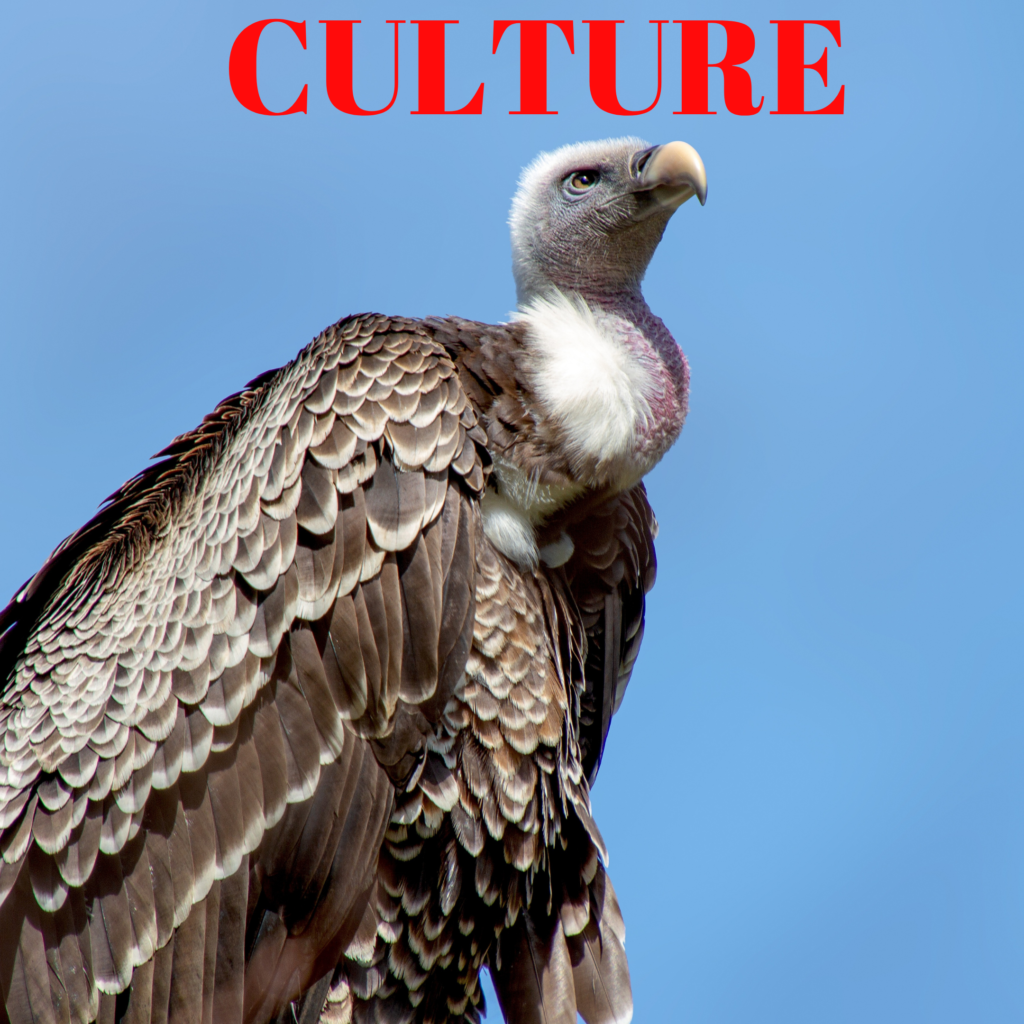This article is based upon observations…
that I have made within my own lifetime, as well as things I have noted in both scripture and history. For sake of article length, I will not go into detail regarding my historical applications of those five steps as they apply to peoples and societies which could be classified as either culture vultures or their victims, I will however list a few examples at the end of this article. Let’s continue…
Culture vultures do the following:
- Appreciate
- Infiltrate
- Imitate
- Eliminate or Exterminate
- Appropriate
Before expounding the individual steps below, please note that the dictionary that I reference heretofore in this article is “The Free Dictionary by Farlex” (iOS version). With that stated, according to the forementioned resource, a vulture (not the bird) is “a person of a rapacious, predatory or profiteering nature.” It is with that definition in mind that I proceed.

Step 1: Appreciation
According to the definition in the digital app, “The Free Dictionary by Farlex,” (iOS version) to appreciate something or someone (among other definitions), is to:
- Recognize the quality, significance or magnitude of.
- Admire greatly or value.
Is that to say that everyone who appreciates something that is not theirs or that they themselves did not create is a vulture? Absolutely not. Some folks have a healthy admiration of beauty, skill, excellence, etc, and can honestly appreciate it where it is. Also keep in mind that appreciation can also be intra-tribal or intra-cultural.
Culture vultures on the other hand almost always come from without (a different tribe, land, culture, etc), and it is their unhealthy appreciation of what they see as so beautiful and so drastically different that serves as the spark that ignites the rest of the process.
Step 2: Infiltration
According to the dictionary definition, to infiltrate is to:
- Enter or take up positions in something gradually or surreptitiously, as for purposes of espionage or takeover.
- Gain or cause to gain entrance or access surreptitiously
Through their excessive outward show of appreciation (also known as “flattery”—see Proverbs 26:28), culture vultures gain either *active or **passive access to whatever the object of their desire is. The keyword to remember in the above definition is “surreptitiously.”
*Active Access: They inject themselves into a place or culture.
** Passive Access: They are invited in by a weak-minded or low-self-esteem-having individual who is overly appreciative of said vulture’s appreciation.
Step 3: Imitation
According to the dictionary definition, to imitate is “to copy the actions, appearance or mannerisms of another; to mimic.”
In modern times we see this a lot with fashion, hairstyles, vernacular and music—especially in the areas of blues, jazz and hip-hop. There are larger-scale applications of this imitation in ancient history and cultures as well (especially those emanating from Northeast Africa, but again for sake of article length I’ll avoid going into detail about them).
Before proceeding to the next step, it is important to note that the sequential order of steps 2 and 3 are not necessarily absolute. Sometimes the imitation occurs before the infiltration, thus greasing the skids and making it easier to proceed to infiltration.
Step 4: Elimination/Extermination
Here I use the terms eliminate and exterminate interchangeably, because historically speaking, either one or the other was carried out depending upon the situation. In the case of culture vultures, elimination ultimately serves the same purpose as extermination, but is typically less severe on both the victim and the conscience of the perpetrator.
According to the dictionary definition, to eliminate is to:
- Get rid of; remove
- Leave out or omit from consideration; reject
On the other hand, to exterminate is “to get rid of by destroying completely.”
(To best illustrate the differences between elimination and extermination, consider for example how throughout history, certain aboriginal tribes around the world were eliminated by being forced onto reservations which typically had poor soil and climate conditions, whereas others were exterminated through direct military action—war/genocide).
There are countless historical examples of Step 4 being enacted by culture vultures. I list a few at the end of this article.
Step 5: Appropriation
Though it can sometimes occur prior to the preceding step, this is typically the final phase of culture vultures being who they are and doing what they do.
According to the dictionary definition, to appropriate is to:
- Take possession of or make use of exclusively for oneself, often without permission.
- To seize for oneself or as one’s right.
- To set apart for a specific use (oftentimes land).
And with appropriation, we have arrived at the final step in the M.O. of culture vultures. Culture vultures ALWAYS begin with appreciation, which simply means “I see it, I like it.” Liking what you see is human nature and in and of itself, is harmless; but culture vultures can never stop with appreciation. For them it is, “I see it; I like it; I WANT IT! (Hmmm… How can I get it?)”
So how does one protect themselves and/or “their stuff” from becoming the spoils of culture vultures?
Well, if we know that the first step in the M.O. of the culture vulture is appreciation, you can cut them off right there. If you want to protect yourself from being robbed by culture vultures the defense is simple… Do not overly appreciate their appreciation of you and what you have. Know your worth. Know your own value and/or the value of what you hold. Don’t fall into this, “Wow! THEY LIKE ME!” syndrome. It may sound a bit arrogant, but if you know your own worth, no one can ever make you feel greater than you already feel about yourself. Believe it or not, it is possible to strike the delicate balance between humility and self-awareness.
When you know your own worth, while you may not be able to prevent someone from imitating you, you canmake it next-to-impossible for them to infiltrate your space to such an end as replacing (or BECOMING) you. Although it is impossible to genetically replace that which is with that which is not (example: I can study the culture and learn to speak Japanese, but I’ll never be Japanese because both my biological parents are what you would call “Afro-American”), still it is possible to eliminate or exterminate the original, then appropriate that which belonged to them, including their culture, identity and history.
Simply put, if you get rid of the original and take over the narrative, it is much easier to “sell yourself as the originator or the original” to any and all who do not know the real story. So, if you want to avoid falling victim to culture vultures, recognize the phases of their M.O.
Now, by no means does the five-step list above apply to everyone that is not part of a particular culture. Here’s why:
- It is common to appreciate someone who has characteristics that are not your own. In fact, differences that are appealing to the senses are often more appreciated than those that are similar to who you are or what is common to you.
- Someone wanting to “be down” or wanting to be around you because they have a strong appreciation for your differences isn’t always infiltration; sometimes it is just a desire to be affiliated or associated for personal enrichment. For the inexperienced, this part can be extremely tricky and the intent is often only perceived by the wise (which is why it is so important to surround yourself with the wise counsel of the elders in your family, community, culture and tribe).
- It has been said that imitation is the greatest form of flattery, so someone imitating you is a typical sign that you are good at what you do (who wants to imitate someone who is unsuccessful anyway, right?). Still, keep in mind the wisdom of Proverbs 26:28 (“A flattering mouth worketh ruin.”). Don’t let someone flattering you lead to your ruin, ESPECIALLY when they’re standing by waiting to take your spot!
In conclusion, though I listed the five steps of how culture vultures operate, what I did not mention is the end result, which is the culmination of those steps.
The end is typically destruction of the original—such that knowledge of who or what the original thing was is little (if at all) known. A good biblical reference of this theme is the Psalm written by Asaph—the chief musician of the Ancient Israelite King Dawad (David). That theme of utterly destroying the original so that it is no longer known is referenced in Psalms 83:1–4 (verse 4: “They have said, Come, and let us cut them off from being a nation; that the name of Israel may be no more in remembrance.”). If verse 4 lends itself to the end result of the five steps, the preceding verse (Psalms 83:3) lends itself to Step 2 above (infiltration) when it reads, “They have taken crafty counsel against thy people.”
In the end, we can tell by the above Psalm (which in effect could have been written from a prophetic vision), that the “culture vulture culture” is not a modern phenomenon (Ecclesiastes 1:9–10). Culture vultures have been around for as long as mankind has been in existence. My sincere hope as the author of this article is that by reading it, you will understand how culture vultures move, what the end game is (destruction—whether intentional or consequential) and that ultimately, culture vultures are nothing more than haters disguised as appreciators. How is this? They appreciate what you have but hate that it is you who has it and not them. Let that sink in and marinate.
All the Best!
—MT
(Continue reading below the bio for a few historical examples of culture vultures and associated video references for table data.)
Matt D. Talford is a writer, narrator, and author of three books: “Stuck In An Elevator” – a fictitious tale of passion and self-discovery; “Captain’s Mate: A Practical Guide for Tennis Captains, League Players and High School Coaches”; and his award-winning debut title: ”From Fear to Faith: A Survivor’s Story” – a memoir about overcoming a rare form of what he calls “the C-word.” All three books are currently available in paperback at www.talfordarts.com or at Amazon.com; and in eBook format on Amazon Kindle and Apple iBooks. “From Fear to Faith: A Survivor’s Story” is also available in audiobook (narrated by Talford himself) at iTunes, audible.com, and at many other sites where audiobooks are sold. For information on these and other products, click the “shop” link in the menu.
CULTURE VULTURE EXAMPLES FROM HISTORY
| Vulture | Victim | Appropriation |
| Ancient Greeks | Ancient Egyptians
|
Land; knowledge of math, science, astronomy, architecture & engineering; music, art and style |
| *** | *** | *** |
| Ancient Israelites | (same as above) | |
| *** | *** | *** |
| Ancient Romans | Ancient Egyptians
|
Land; knowledge of math, science, astronomy, architecture & engineering; music, art and style |
| *** | *** | |
| Ancient Israelites | Land; knowledge of math, science, astronomy, architecture & engineering; music, art and style; silver, gold, heirlooms & artifacts looted from the Temple of Solomon in Ancient Jerusalem prior to its complete destruction; manpower (slaves); teachings of the Messiah (later mixed with pagan principles and practices, then rebranded as Christianity); imagery (replaced images of historical “Black” peoples with paintings, engraving, statues, and busts that were Eurocentric in appearance) | |
| *** | *** | *** |
| Ancient Khazars | Ancient Israelites (Scattered) | Language and way of life (mixed with Ancient Babylonian practices and rebranded as Judaism) |
| *** | *** | *** |
| 8th–15th Century Spanish & Portuguese | Scattered Ishmaelites and Israelites (Collectively known as “The Moors”) | Modern number system (which replaced Roman numerals); mathematics; science; medicine; language (see video reference below); fashion; music; art; architectural style |
| *** | *** | *** |
| 15th, 16th, 17th Century Europeans (Spanish/Portuguese/
Dutch/French/English) |
Various Nations & Tribes on the African Continent, Aboriginal (“Black”) Americans, Aboriginal Australians, Aboriginal Pacific Islanders and other Indigenous Peoples | Land, Precious Metals and Stones, Other Artifacts |
| *** | *** | *** |
| 17th & 18th Century English | “Black” Nobility in the Islands of the Sea (Isaiah 11:11) and the Isles Afar Off (Jeremiah 31:10) | Land, History and Identity
(See video Ref below)
|
Similarities between Arabic and Spanish
***










